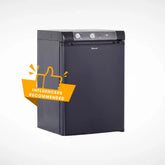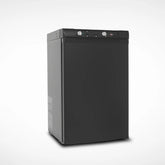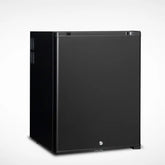Safety tips for using a propane refrigerator
When it comes to any appliance that’s powered by a flame, safety’s a pretty big deal. Especially for propane fridges. Propane fridges are safe partly because they have no moving parts. However, be aware that they include ammonia and you should also follow best practices when using propane cylinders.
If we wonder if it is safe to use a propane refrigerator, we need to know how it works.

Propane fridges are economical and don’t require an outside power source. The sealed cooling system located at the rear of the propane-powered fridge holds water, liquid ammonia, and hydrogen gas and uses a propane flame to heat the water and ammonia to their boiling point in what is called a generator. The gas material then rises into a condensing chamber where it cools and returns to fluidity. This fluid then flows into another chamber - the evaporator—where it mixes with hydrogen gas. It’s here that a chemical reaction occurs that pulls or absorbs heat from inside the refrigerator. Once the solution absorbs enough heat, the ammonia returns to a gas state, starting the process over again.
The fridge itself
That the Fridge Itself has no moving parts means there’s nothing inside going to be grinding or rubbing against other parts like in 99% of modern appliances. They’re completely silent and rarely, if ever, require maintenance. This is why these fridges have such massive lifespans, and will last decades if you treat them right.
Working With Propane
Using combustible fuel to operate appliances sounds dangerous, but propane’s actually very safe when following regulations and codes. The most important tips are related to good ventilation because the carbon monoxide given off during the propane-burning is a real danger if it replaces too much oxygen in the air.
There are a few best practices to bear in mind:
1. Handle with care.
2. Keep secured. Especially when transporting propane tanks.
3. Do not leave in an enclosed space. (Storage rooms, cars/trucks).
4. Don’t run the tank to empty. This can increase leak chances when the tank is refilled. Try to refill/replace 5-10% remaining.
5. Check for leaks. More on this below.
6. Ventilate properly. As above!
If you smell gas, make sure to immediately extinguish any open flames. Turn off the gas valve, and leave the area. If you’re worried or doubtful, call your propane supplier and inform them of the situation. If that doesn’t work, don’t be afraid to call the police. Make sure you get the system checked before using it again.

Propane Fridge Best Practices
There are a few best practices you should stick to when using a propane fridge. These will make sure you get the most out of it, and make sure it’s as safe as possible.
1. Allow 1″ for airflow.
One note is that there is heat involved with the fridge. Both via the propane flame, and the chemical reaction in the fridge. To allow this to dissipate properly (and to maximize efficiency), make sure to keep at least a 1″ gap for airflow around all sides of the fridge.
2. Keep Level
It’s important to remember that these fridges work using chemical reactions. For these liquids and gases to flow properly, the fridge needs to be level. Any good fridge model will have extendable feet, so you should be able to easily adjust the level accordingly.
If using in an RV, make sure to re-check the level whenever you change location.
3. Check Gas Sources for Leaks
Before use, you must check your propane tanks for leaks. Thankfully, this is super simple. Just take some soapy water and give the tanks a good going over with a light scrub. Once they’re covered, open the manual valve and keep a keen eye out for any bubbles. If you see any leaks? Close the valve and replace the tank at your nearest store and let them know you suspect a leak!
Featured Products
SMAD 1.4 cu.ft Mini Gas Propane Refrigerator, 3-WAY Small Portable Camper Fridge
- $377.08
$427.90- $377.08
- Unit price
- / per
SMAD 2.1 cu.ft (60 liter) 3 Way Propane Camper Fridge for Travel, Quiet Refrigerator without Freezer
- from $449.88
$504.90- from $449.88
- Unit price
- / per
SMAD 3.5 cu.ft Propane Refrigerator with Freezer, 3 Way Gas Fridge Freezer
- $1,103.08
$1,274.90- $1,103.08
- Unit price
- / per
SMAD 6.1 Cu.ft Propane Refrigerator with Top Freezer, Off-Grid Camper Gas Fridge
- $1,508.00
$1,686.00- $1,508.00
- Unit price
- / per
SMAD 2.4 Cu.Ft Propane Gas/110V/12V Chest Freezer for Camping,Off-grid Cabin Freezer
- $909.08
$1,065.90- $909.08
- Unit price
- / per
SMAD 1.4 cu.ft Quiet 12V Absorption Cooling Portable Fridge with Lock for Camper and Travel
- $311.88
$350.90- $311.88
- Unit price
- / per
SMAD 2.1 cu.ft Silent Absorption Refrigerator with Lock, 12V Outdoor Camper Refrigerator
- $367.08
$416.90- $367.08
- Unit price
- / per
SMAD 3.0 Cu.Ft (85L) RV Refrigerator with mini top freezer, 12V/24V DC Travel and Camper Fridge
- $643.08
$699.00- $643.08
- Unit price
- / per















